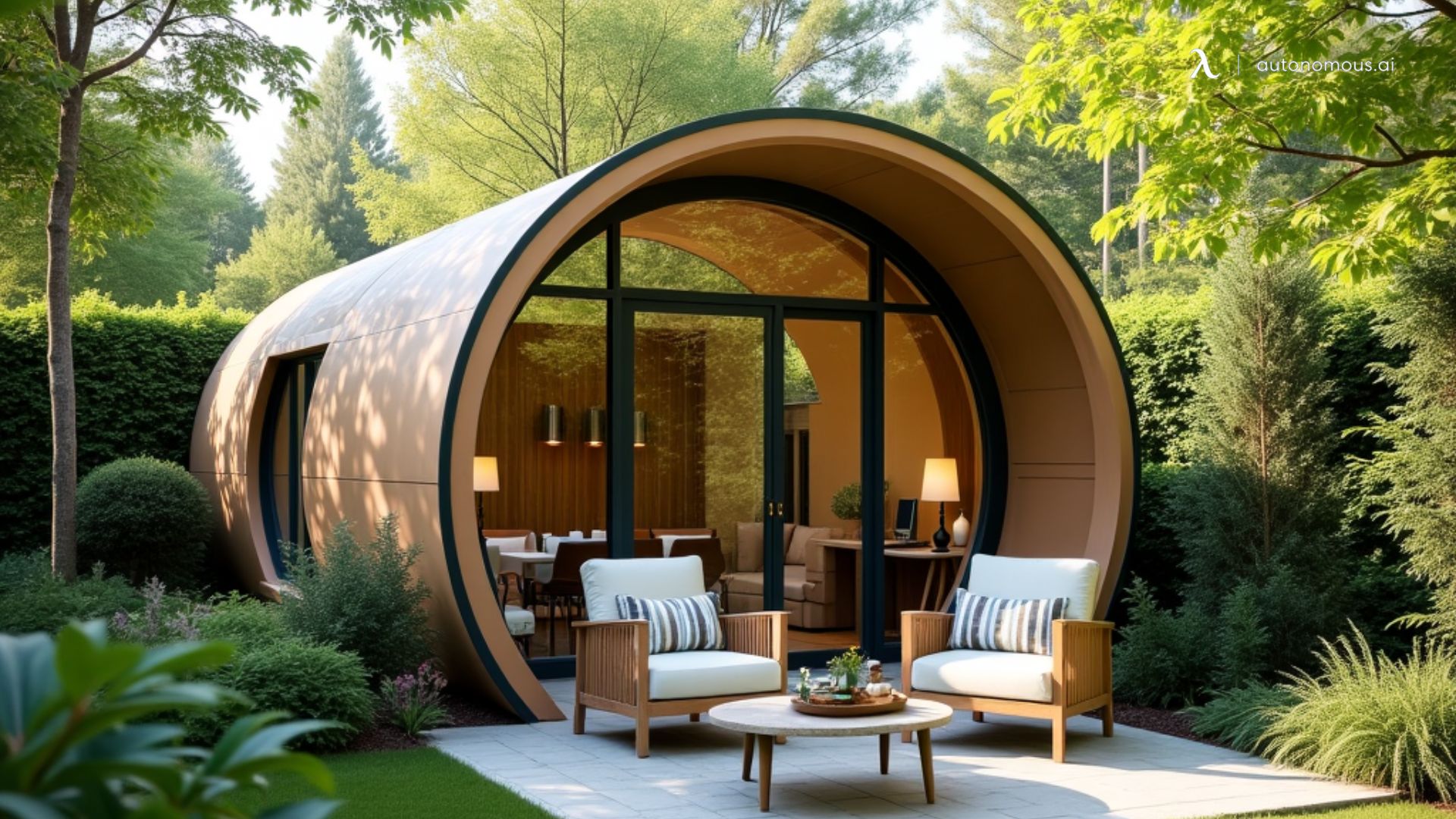
Top 3 Small Prefab ADUs Under $100K for Budget-Conscious Homeowners
Table of Contents
Prefab ADUs (Accessory Dwelling Units) have become an affordable and practical solution for homeowners looking to add extra space without extensive construction costs. With ADUs under $100K, you can create a versatile, comfortable addition to your property—whether it’s for a home office, studio, or guest suite—at a fraction of the cost of traditional builds. This blog will explore why small prefab ADUs are ideal for budget-conscious homeowners, compare top ADUs available for under $100K, and answer common questions to help you make an informed decision.
1. Why Small Prefab ADUs Are the Smart Choice
For homeowners on a budget, prefab ADUs under $100K offer an efficient way to add functional space without a full-scale home addition. Here’s why small prefab ADUs are a great choice for those seeking affordability:
1.1. Cost-Effectiveness
Prefab ADUs under $100K offer a highly cost-effective solution compared to traditional home additions or custom-built ADUs. By choosing a cheap prefab ADU, homeowners can save significantly on labor and materials costs. For instance, the ADU cost Bay Area often exceeds $350,000, due to high labor and material expenses, and even in other parts of California, costs remain high.
The cost of an ADU in California generally ranges between $150,000 and $300,000, driven by factors like customization, permits, and regional building fees. In Los Angeles, for instance, ADU cost in Los Angeles is typically between $150,000 and $300,000, depending on specific local regulations and permit fees.
Smaller prefab ADUs provide a streamlined approach to costs, often keeping the project well under $100K. This affordability makes them appealing for budget-conscious homeowners who want additional space without extensive expenses. In other California cities, like Sacramento, ADU cost Sacramento can range from $150,000 to $250,000, while ADU cost San Diego is similarly priced. By comparison, a prefab ADU under $100K provides a far more accessible option.
To help with budgeting, understanding a complete ADU cost breakdown is useful. It details expenses, from materials to permits, allowing homeowners to plan accurately. With a prefab ADU under $100K, you can create an efficient, comfortable space without high upfront costs.
1.2. Quick Installation
Unlike custom-built additions, which may take months, prefab ADUs are pre-constructed off-site and can be installed on your property in days or weeks. This not only saves time but also minimizes disruption to your home.
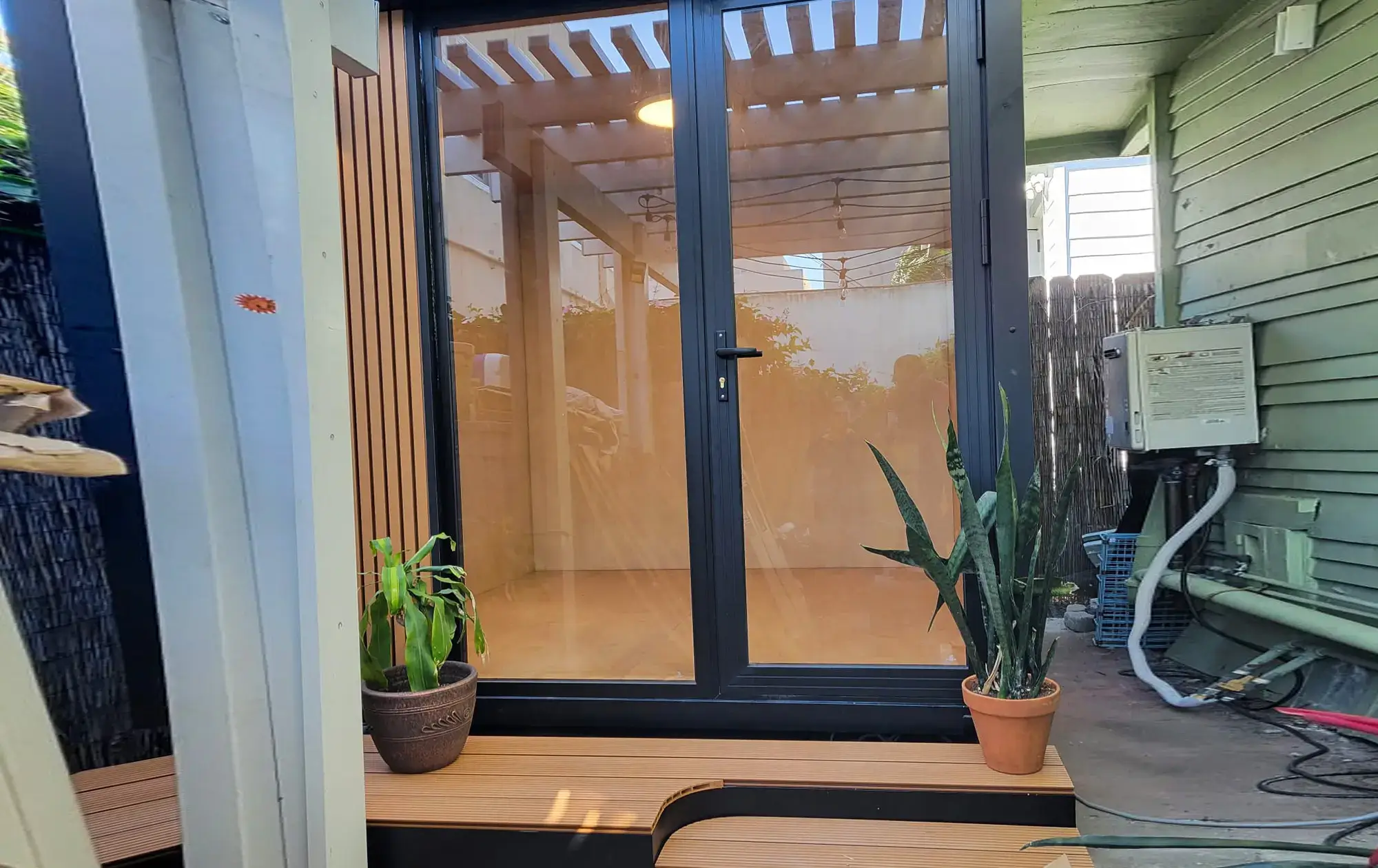
1.3. Versatile Use
A small prefab ADU under $100K is incredibly versatile, adapting to various needs over time. Homeowners can transform their prefab ADU into a backyard man cave shed or a she shed—perfect for relaxation, hobbies, or as a personal retreat.
For remote work, a backyard office shed offers privacy and productivity just steps from home. Creatives can convert an ADU into a home music studio or a backyard art studio, providing dedicated spaces for art or music.
Fitness enthusiasts can enjoy a backyard gym, while gamers and readers may prefer a backyard gaming shed or backyard reading room, designed for focused leisure. Writers, too, can benefit from a writing shed as a peaceful, productive workspace.
With a prefab ADU, homeowners can create unique, functional spaces that elevate property value and enhance daily life.
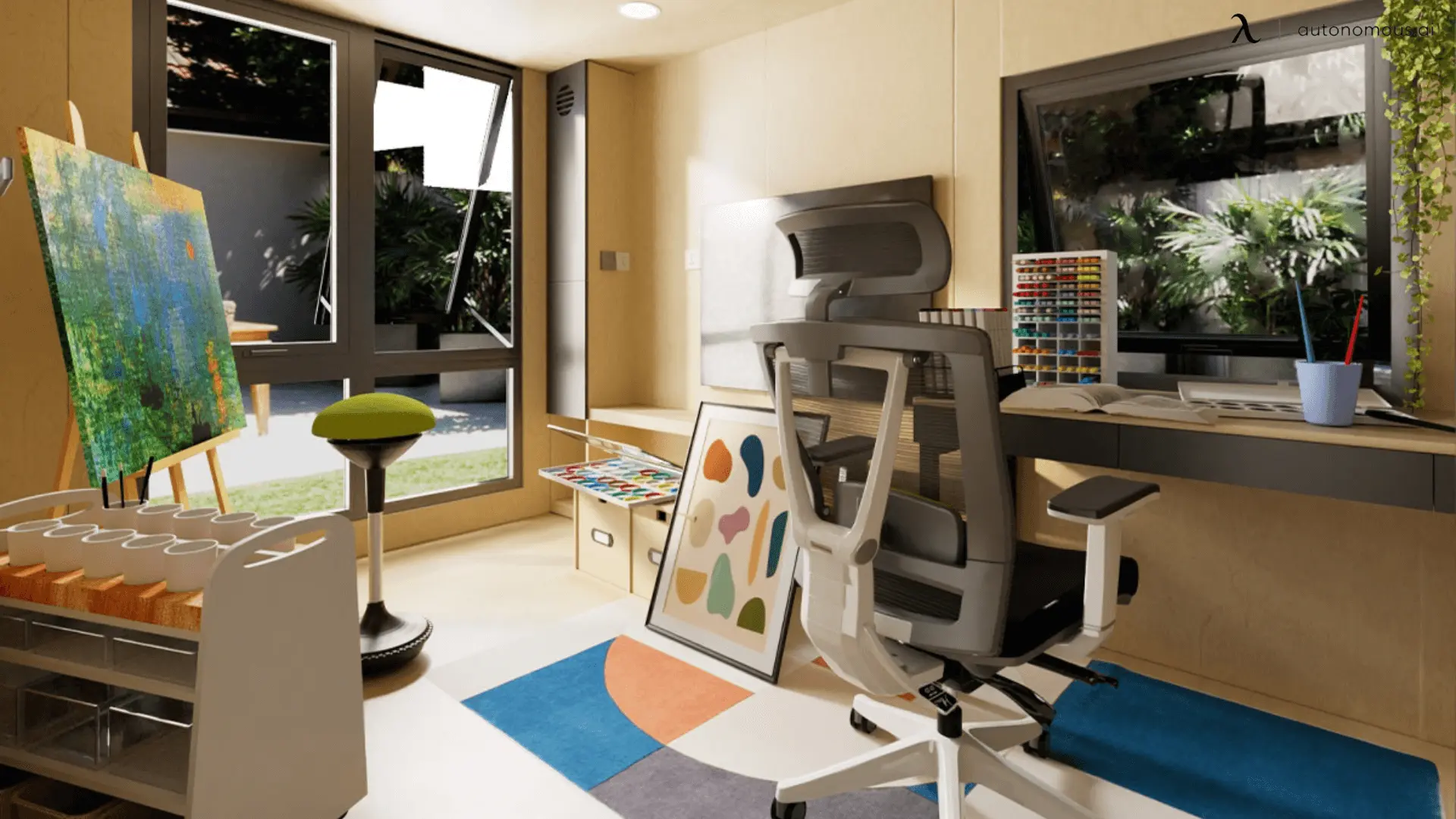
1.4. Minimal Permitting Requirements
Due to their compact size, many small prefab ADUs don’t require extensive permitting. While permit requirements vary by locality, smaller units are often easier to get approved, streamlining the installation process.
For instance, homeowners looking to install an ADU in California might explore San Jose ADU permit requirements, which outline the specific guidelines and permits needed to comply with local laws. Regulations in places like San Jose often include specific height, setback, and parking requirements that homeowners need to follow when adding an ADU.
Similarly, those interested in building in the Southeast can check ADU permit requirements in Georgia to understand local restrictions and ensure compliance. In Georgia, for example, permit processes may vary based on whether the ADU is attached or detached, as well as the intended use of the unit.
For those just beginning the process, a general guide on how to get an ADU permit can be invaluable. This guide covers the general steps to obtaining an ADU permit in the U.S., helping homeowners understand the documents, fees, and inspections involved.
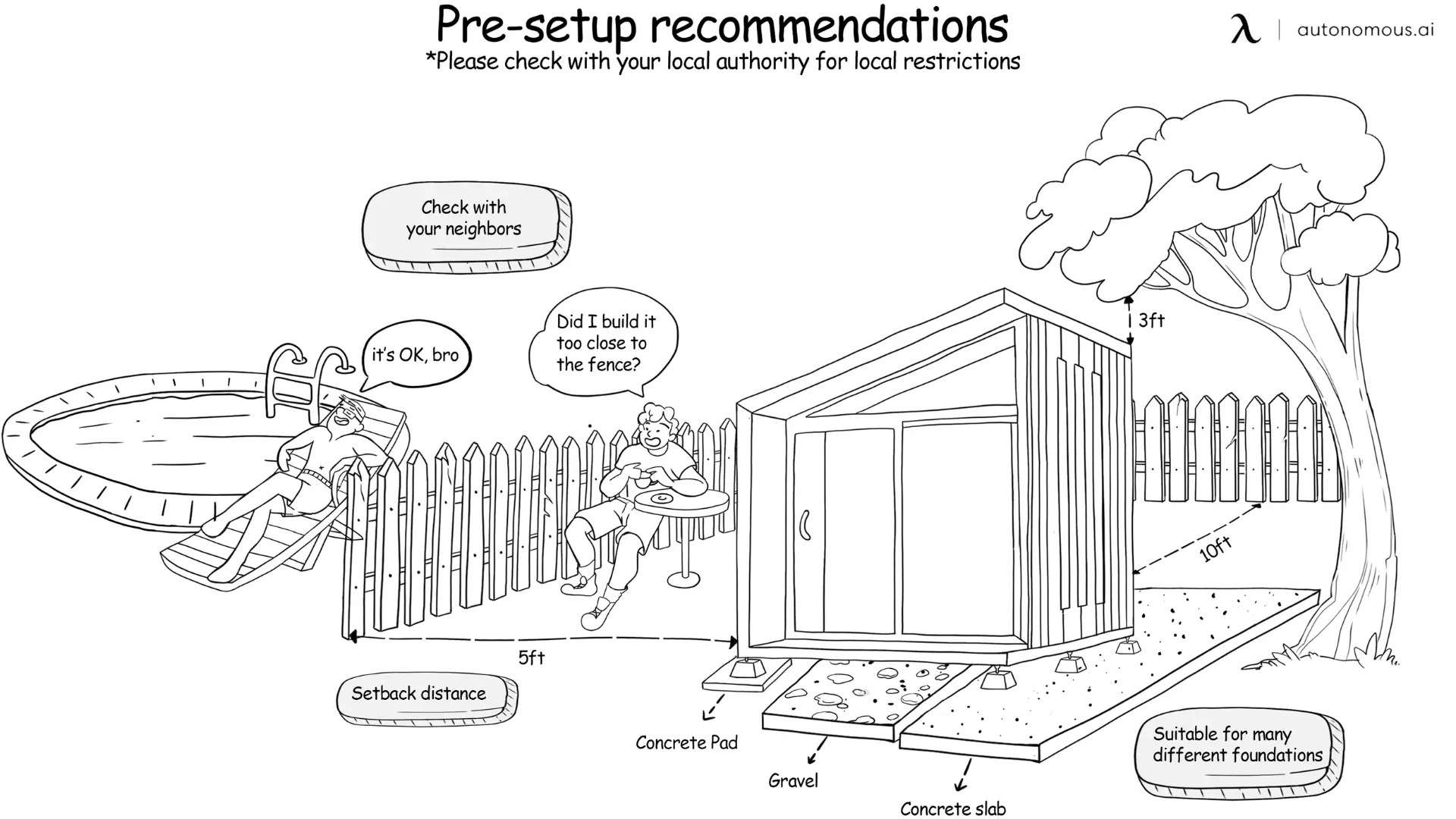
1.5. Energy Efficiency
Energy efficiency is a key benefit of small prefab ADUs, helping homeowners save on utility bills while creating more sustainable spaces. Many prefab ADUs come equipped with insulated walls, double-glazed windows, and low-energy lighting, all of which help maintain comfortable temperatures with minimal energy use. Solar power options are also increasingly popular, offering renewable energy for added savings.
In California, ADU solar requirements outline how to integrate solar systems on ADUs for compliance and long-term savings. For DIY enthusiasts, a DIY solar system for a shed is a cost-effective way to power a small ADU, allowing homeowners to control costs and meet their power needs independently. Another option for sustainability is solar panels for small houses, which provide sufficient energy for everyday essentials in compact homes.
Adding electrical capabilities further enhances ADU functionality. Converting a she shed with electricity or running electric to a shed supports lighting, heating, and appliances, while office sheds with electricity make a seamless setup for work-from-home spaces.
2. Best Prefab ADUs Available Under $100K
If you’re looking for a small prefab ADU under $100K, here are some top options, each with unique features to fit various needs and lifestyles.
2.1. Autonomous WorkPod
The Autonomous WorkPod is a dedicated office pod designed to provide a focused workspace away from home distractions. It’s ideal for remote professionals or creatives seeking a compact, fully equipped office.
- Key Features: Sound-insulated walls, floor-to-ceiling glass doors, built-in electrical setup for easy plug-and-play use.
- Best For: Home office, creative workspace, or studio
- Design: Modern, minimalist design that easily fits into a backyard setting
- Setup Time: Quick installation, ready in days
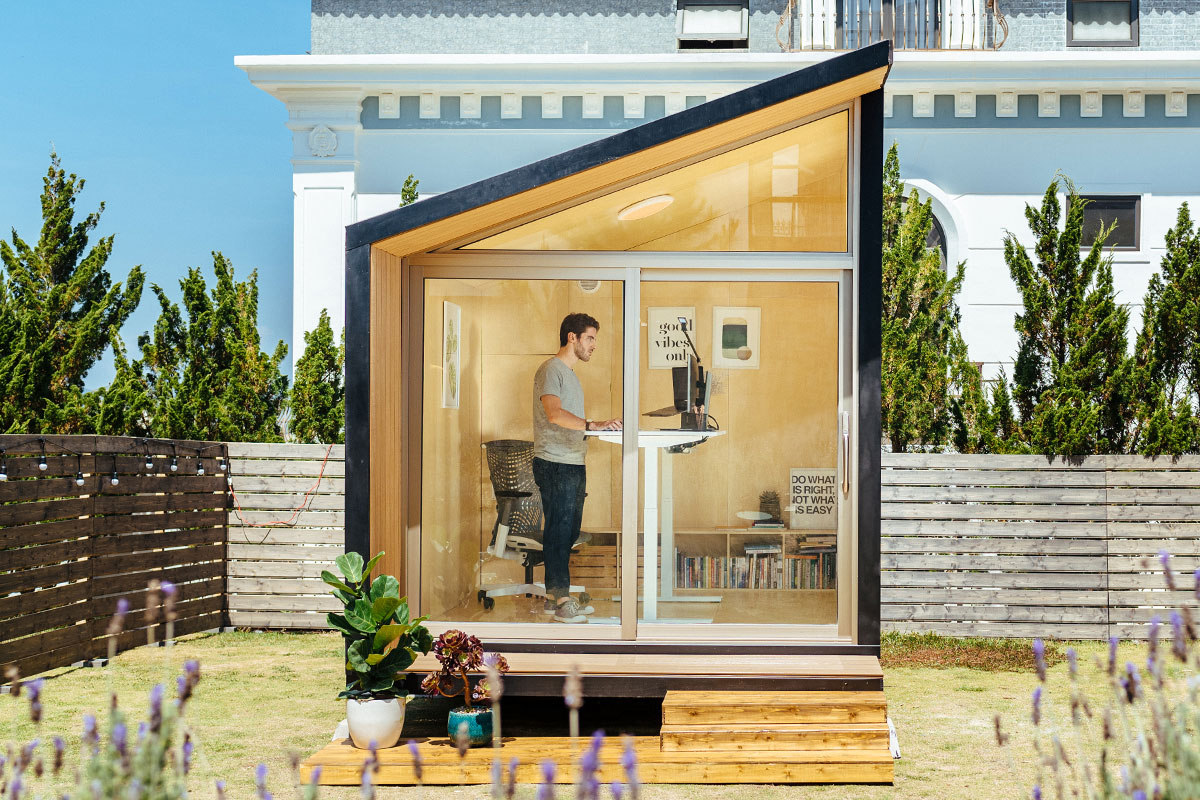
WorkPod
| Overall size | 8.5’W x 12’L x 11’H |
| Floorspace | 102 square feet |
| Ceiling height | 6.8’ to 9.3’ |
| Weight capacity | 2.9 tons |
| Door & Window dimensions, material (include glass) | Main door: 7.5’W x 6.8'H 3 windows: 1.1’W x 7.9’H Window material: Wooden frame, 5/16” tempered glass, composite wood cover Door material: Anodized aluminum frame, 5/16” tempered glass |
| Siding, roof, floor & balcony material | Siding: Plywood 1/2”, wooden frame, honeycomb paper, plywood 3/8”, bitume, housewrap, vinyl siding Roof: Roof shingles Floor: Plywood Balcony: Composite wood |
| Electrical devices | 1 RCB (Residual current breaker) 3 Wall outlet (Universal wall sockets) 1 Ceiling light switch 1 Ceiling light 1 Ventilator switch 1 Ventilator 66ft power cable with 2 connectors |
| Power input | Maximum voltage: 110V AC (US standard) Maximum current: 25A Maximum power dissipation: 2750W |
| Interior furniture | Unfurnished option: 1 Bookshelf, 1 Electrical Cabinet Furnished option: 1 SmartDesk Connect, 1 Autonomous Chair Ultra, 1 Monitor Arm, 1 Cable Tray, 1 Filing Cabinet, 1 Anti-Fatigue Mat, 1 Bookshelf, 1 Electrical Cabinet |
| Compatible with | Portable air conditioner: A/C units with dimensions smaller than 22” L x 20” W x 88” H and a 5.9” vent hole diameter will fit well. Heater: A small personal heater is more than sufficient. |
2.2. Autonomous WorkPod Versatile
The Autonomous WorkPod Versatile (often called the StudioPod) is a multi-functional ADU designed with built-in furniture and flexible layout options, making it perfect for homeowners seeking a compact yet complete workspace.
- Key Features: Includes a built-in desk, bookshelf, closet, foldable coffee table, and convertible sofa bed
- Best For: Office, personal studio, or compact, versatile workspace
- Design: Stylish and modern, optimized for productivity and comfort
- Setup Time: Fast installation; easily assembled within days
/https://storage.googleapis.com/s3-autonomous-upgrade-3/production/ecm/240412/StudioPod-2.jpg)
WorkPod Versatile
| Overall size | 8’4”W x 12’6”L x 9’10”H |
| Floorspace | 105 square feet |
| Ceiling height | 7’3” |
| Weight capacity | 2.9 tons |
| Pedestal | 18”W x 43”L x 7”H |
| Door & Window dimensions, material (include glass) | Main door: 39”W x 89”H Large window: 59”W x 81”H Small window: 39”W x 39”H Window & door material: Powder coated aluminum, 5/16” tempered glass |
| Siding, roof, floor & balcony material | Siding: Plywood 1/2”, steel frame, honeycomb paper, plywood 3/8”, bitume, housewrap, vinyl siding Roof: Roof shingles Floor: Plywood Pedestal: Steel frame & wood plastic composite |
| Electrical devices | 1 RCB (Residual current breaker) |
| Power input | Maximum voltage: 110V AC (US standard) Maximum current: 25A Maximum power dissipation: 2750W |
| Furniture (optional) | Cabinet, Desk, Small & Big Bookshelf, TV Shelf, Foldable Sofa Table & Electrical Cabinet* (*Electrical Cabinet always included) |
2.3. Autonomous WorkPod Mini
The Autonomous WorkPod Mini is a budget-friendly, compact pod designed for smaller outdoor spaces. It provides essential workspace features in a compact design, making it perfect for those with limited space or a smaller budget.
- Key Features: Compact layout, sound insulation, efficient workspace design
- Best For: Dedicated home office for one or two people
- Design: Sleek, minimalistic, and functional, fitting well in small yards
- Setup Time: Quick assembly, ready for use shortly after setup
Each of these WorkPods provides a cheap prefab ADU solution that’s tailored for efficiency and comfort. From a single workstation to a multi-functional office, these options are ideal for budget-conscious homeowners looking for high-quality prefabs under $100K.
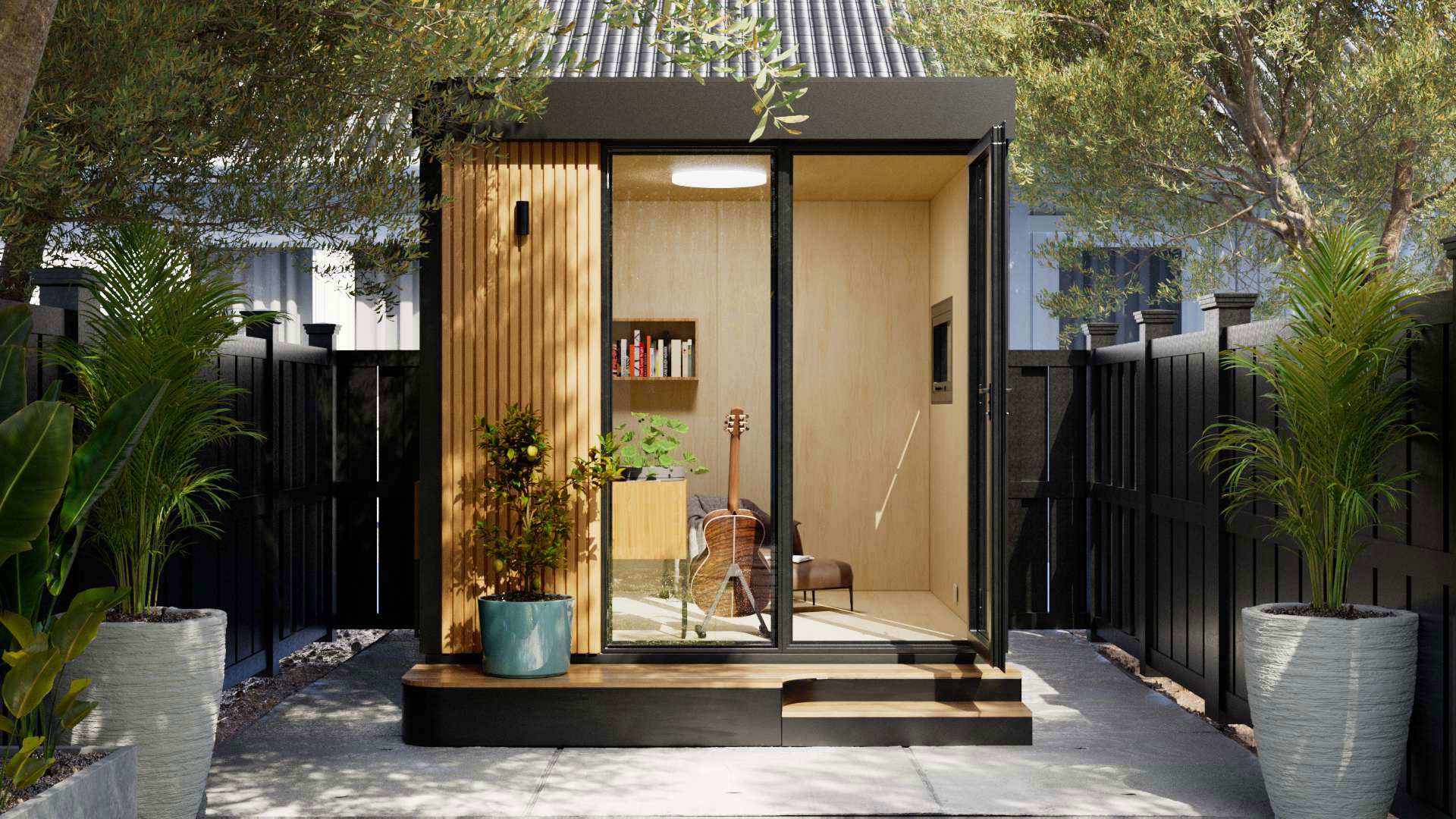
WorkPod mini
| Dimension | Overall size: 8’7"W x 9’L x 9’3"H Floorspace: 80 square feet Ceiling height: 7’3" Weight capacity: 2.3 tons (including Pod body) Pedestal: 24"W x 103"L x 9"H |
| Door & Window dimensions, material (include glass) | Main door: 37"W x 89"H (open side) & 33"W x 89"H (fixed side) Window: 43"W x 20"H Window & door material: Powder coated aluminum, 5/16" tempered glass |
| Siding, roof, floor & balcony material | Siding: Plywood 1/2" , steel frame, honeycomb paper, plywood 3/8", bitume, housewrap, vinyl siding Roof: Metal roofing Floor: Plywood Balcony & Pedestal: Steel frame & wood plastic composite |
| Electrical devices | 1 RCB (Residual current breaker) 2 Wall outlet (Universal wall sockets) 1 Ceiling light switch 1 Ceiling light 1 Wall light 1 Ethernet wall port 66ft power cable with 2 connectors |
| Power input | Maximum voltage: 110V AC (US standard) Maximum current: 25A Maximum power dissipation: 2750W |
3. Prefab ADU vs. Prefab Home: Key Differences
If you’re weighing the choice between a prefab ADU and a full prefab home, here are the main differences to consider:
| Feature | Prefab ADU | Prefab Home |
|---|---|---|
| Purpose | Additional space on a property with a main residence | Standalone, primary residence or vacation home |
| Size | Generally smaller, typically 200 - 800 sq. ft. | Larger sizes, often between 500 - 2,000 sq. ft. |
| Permits | Often simpler, depending on local zoning laws | Full residential permits required |
| Utilities | Typically shares utilities with main home | Independent utility setup needed |
| Cost | More affordable, especially for ADUs under $100K | Higher cost due to larger size and full amenities |
The WorkPod is unique among other brands for its fully optimized setup, which comes with all necessary components, including a foundation, and can be assembled within just 2-3 days. Additionally, the WorkPod's cost includes essential features such as windows, a door, and interior lifestyle enhancements. The table below provides a comprehensive cost comparison, emphasizing the exceptional value and convenience that the WorkPod offers in contrast to other brands.
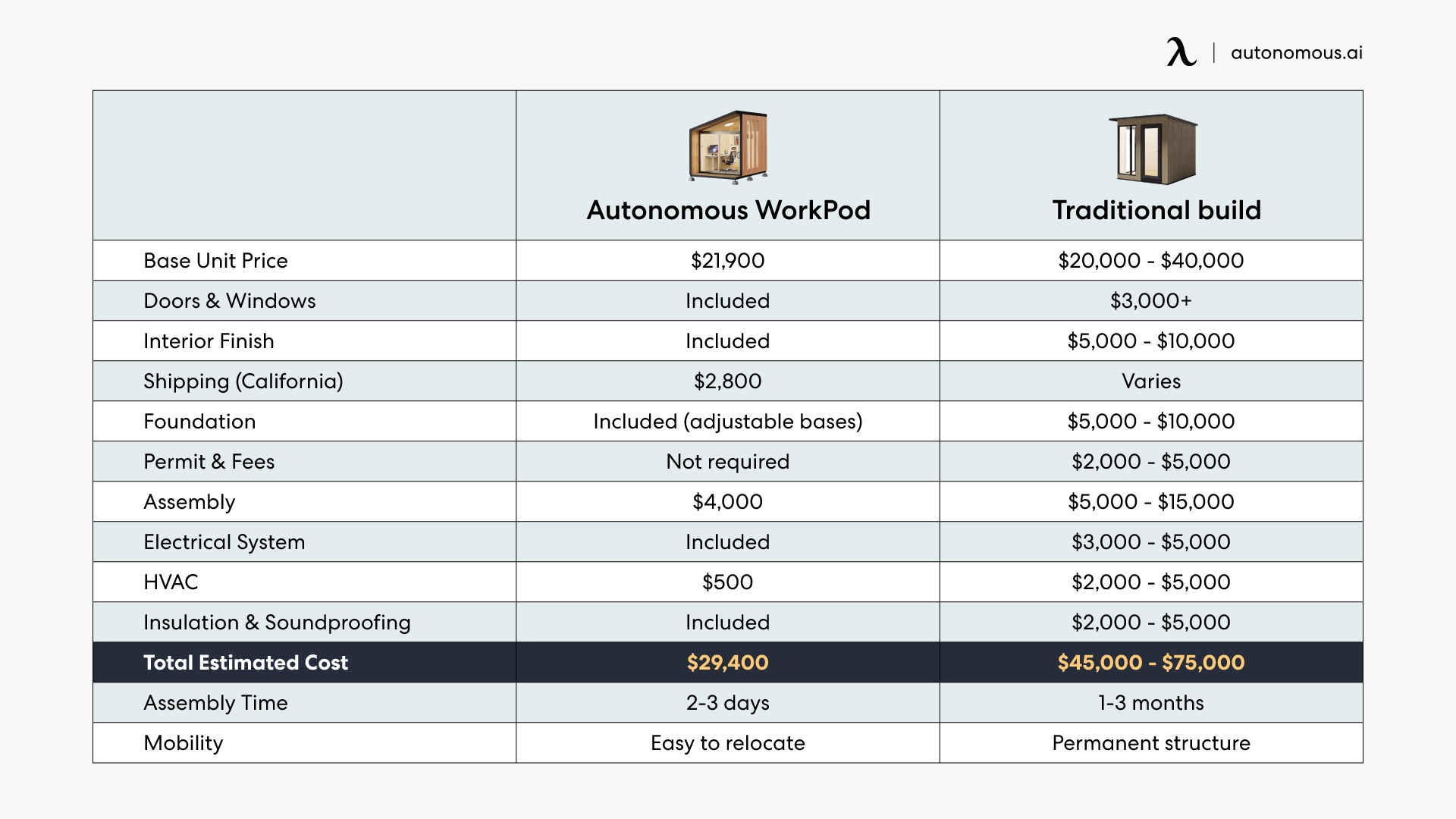
4. FAQs
How much does a small prefab ADU under $100K typically cost?
While most prefab ADUs under $100K start around $50,000, prices can vary based on customization, materials, and additional installation or permit fees.
What is the installation time for a prefab ADU?
Many prefab ADUs are designed for quick setup, with some models like the Autonomous WorkPods installed in just days. Overall, most prefab ADUs can be installed within a few weeks, significantly faster than traditional builds.
Are there financing options for cheap prefab ADUs?
Yes, there are financing options available, including personal loans, home equity loans, and specialized prefab financing programs offered by some manufacturers.
Do small prefab ADUs require permits?
Permit requirements vary by location, but many small prefab ADUs have simplified permit processes. Check with your local zoning office to confirm what’s needed.
What are the common uses for a small prefab ADU?
Common uses include a home office, studio, guest suite, or even a rental unit, depending on local regulations. Many homeowners also use them as private spaces for focused work or hobbies.
Can a small prefab ADU add value to my property?
Yes, an ADU can increase your property’s value by adding functional living or workspace. It may also provide rental income if your area permits short-term or long-term rentals.
Are prefab ADUs energy efficient?
Many prefab ADUs come with energy-efficient features, including insulated walls and windows. Some units offer solar power options, reducing utility costs and environmental impact.
How does a prefab ADU differ from a modular home?
A prefab ADU is typically smaller and designed as an addition to an existing property, while modular homes are often standalone residences. Modular homes are generally larger and require more complex permits.
Are there any special requirements for building an ADU in Malibu?
Yes, Malibu has strict guidelines for ADU construction to maintain the city’s natural aesthetics. To build an ADU in Malibu, you’ll need to follow specific zoning rules. Prefab ADUs simplify the process, helping you achieve compliance with Malibu’s standards.
Can I add a prefab shed to my property in New Mexico?
Yes, New Mexico sheds are popular additions, particularly for homeowners looking to add storage or workspace. Local zoning regulations vary, but prefab sheds are generally straightforward to install, providing extra space with minimal permitting requirements.
Conclusion
Small prefab ADUs under $100K offer a cost-effective, flexible solution for homeowners looking to add extra space without major renovations. With a variety of models available, these units can serve as a home office, studio, guest suite, or any customized space that fits your lifestyle needs.
For homeowners in different regions, prefab ADUs provide accessible options that comply with local building regulations. Those planning a prefab ADU in Connecticut or an ADU in Long Island, NY, for example, can find options that align with zoning laws and requirements. Similarly, a prefab ADU in Maryland or prefab ADU in Colorado can be adapted to meet local codes efficiently.
Investing in a prefab ADU under $100K allows you to maximize property value, enhance your living space, and create a practical, cost-effective addition that supports your goals and lifestyle. If you’re considering an ADU in Massachusetts, prefab options offer a flexible solution that can be adapted to meet local building standards.
Stay connected with us!
Subscribe to our weekly updates to stay in the loop about our latest innovations and community news!
Interested in a Link Placement?
Spread the word
.svg)
.svg)

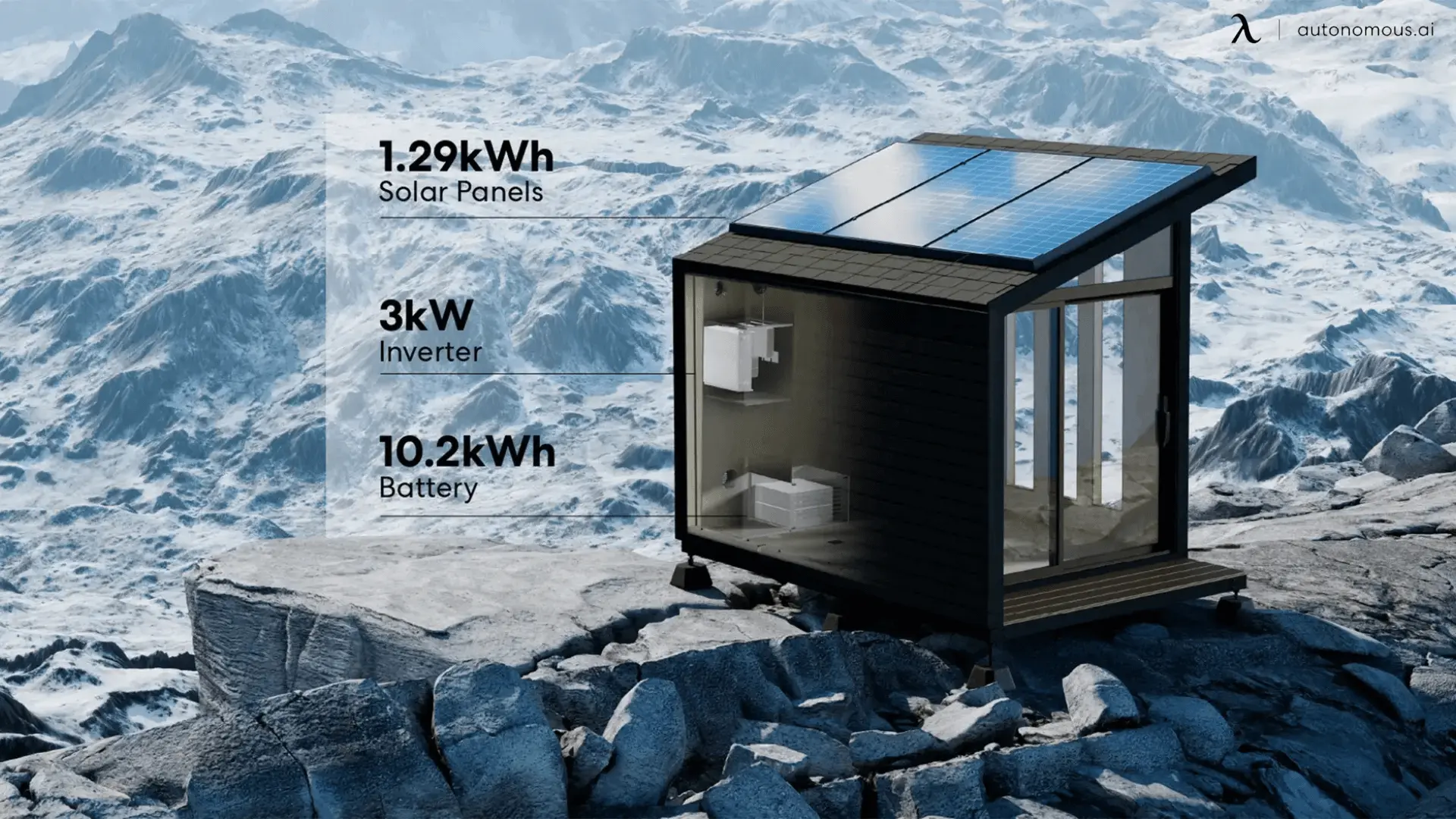

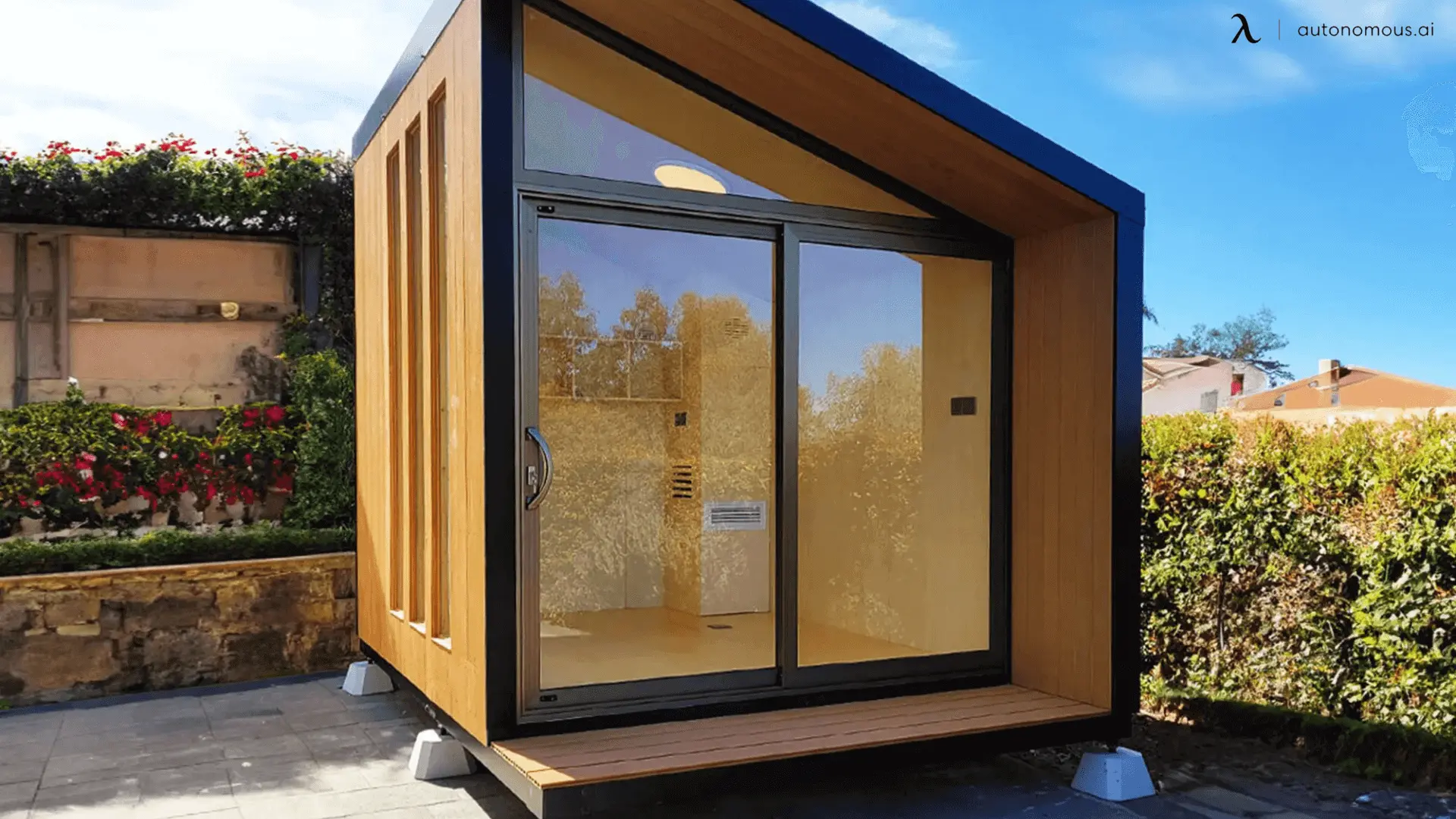
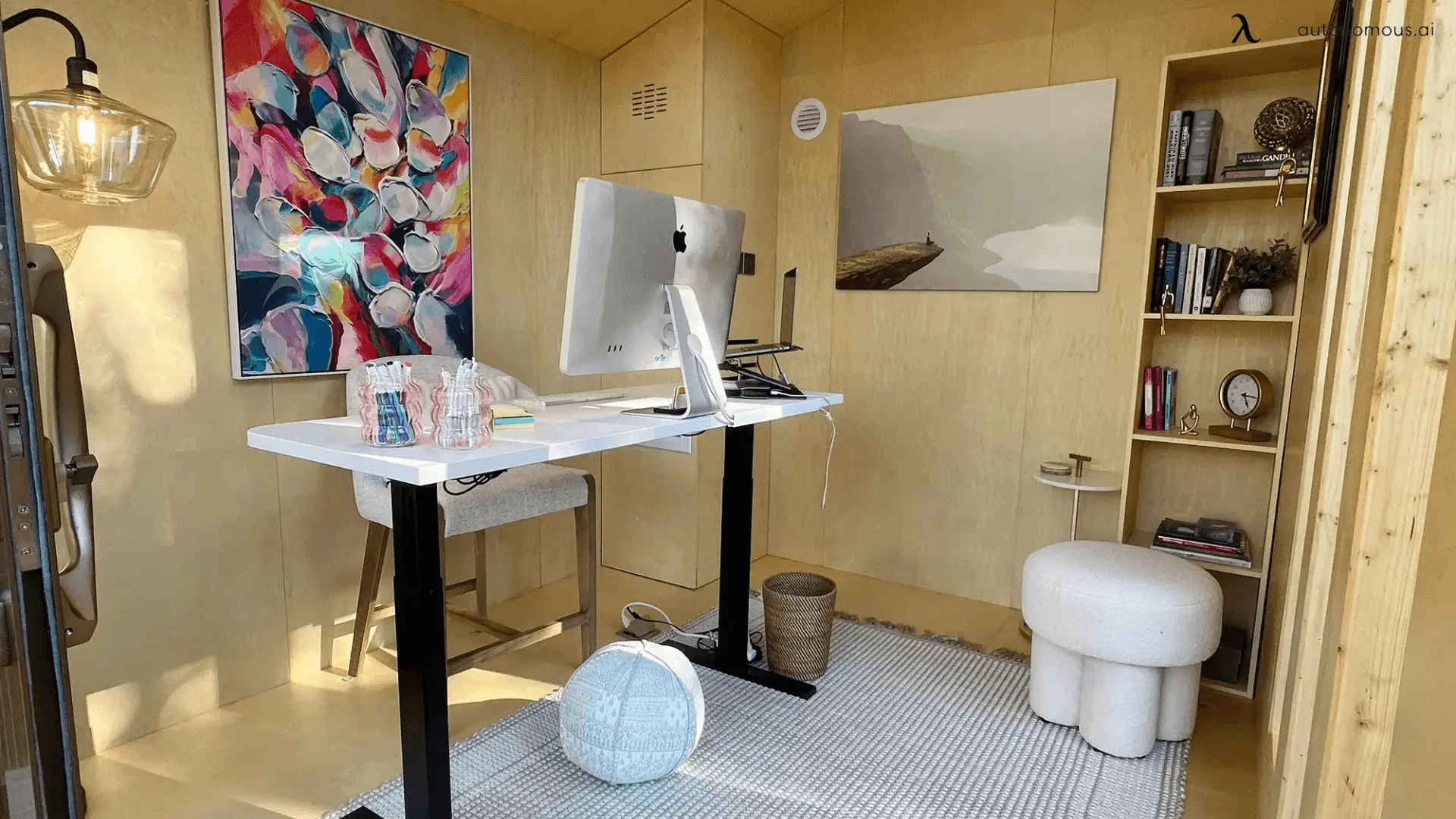
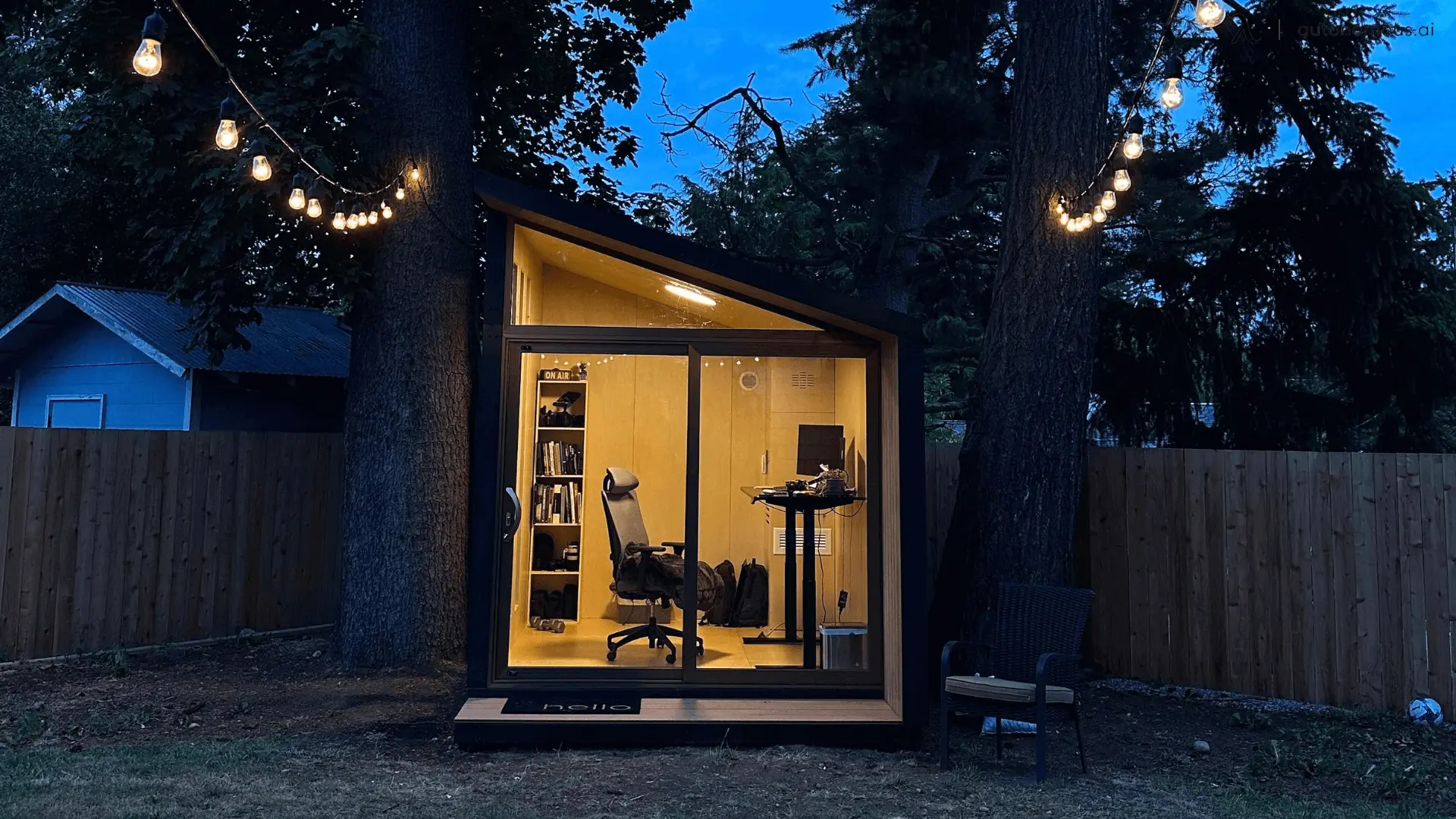
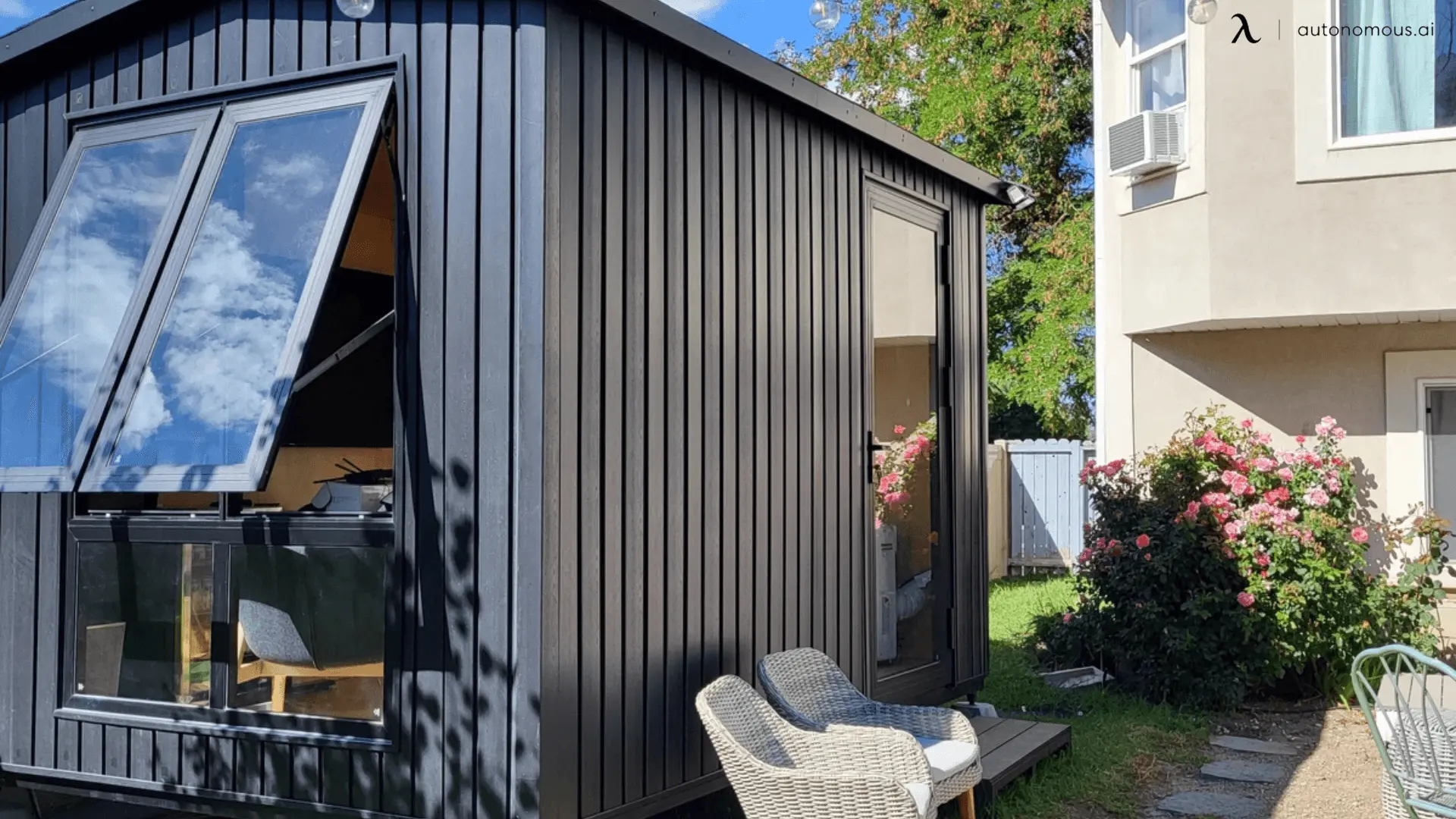
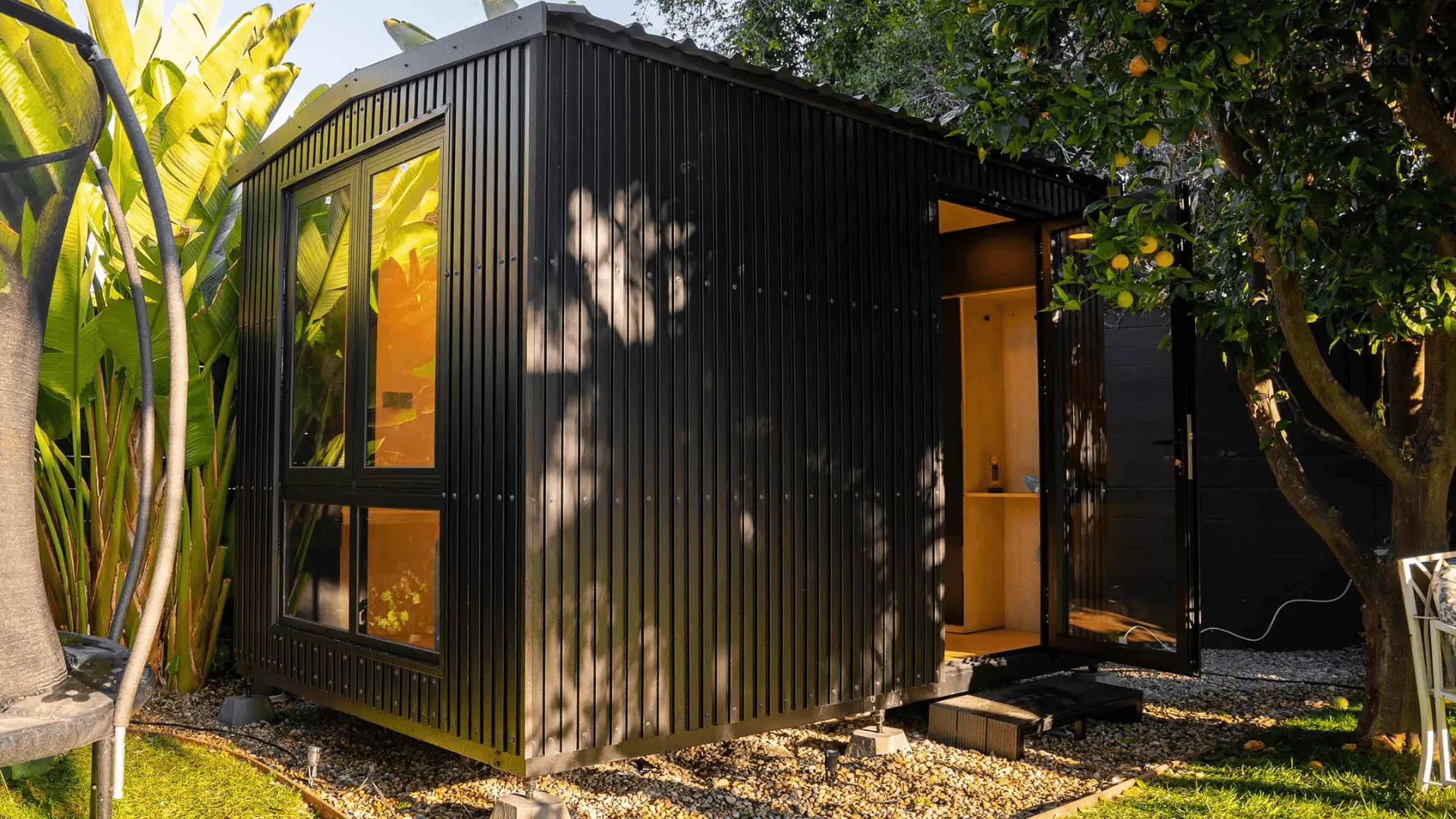
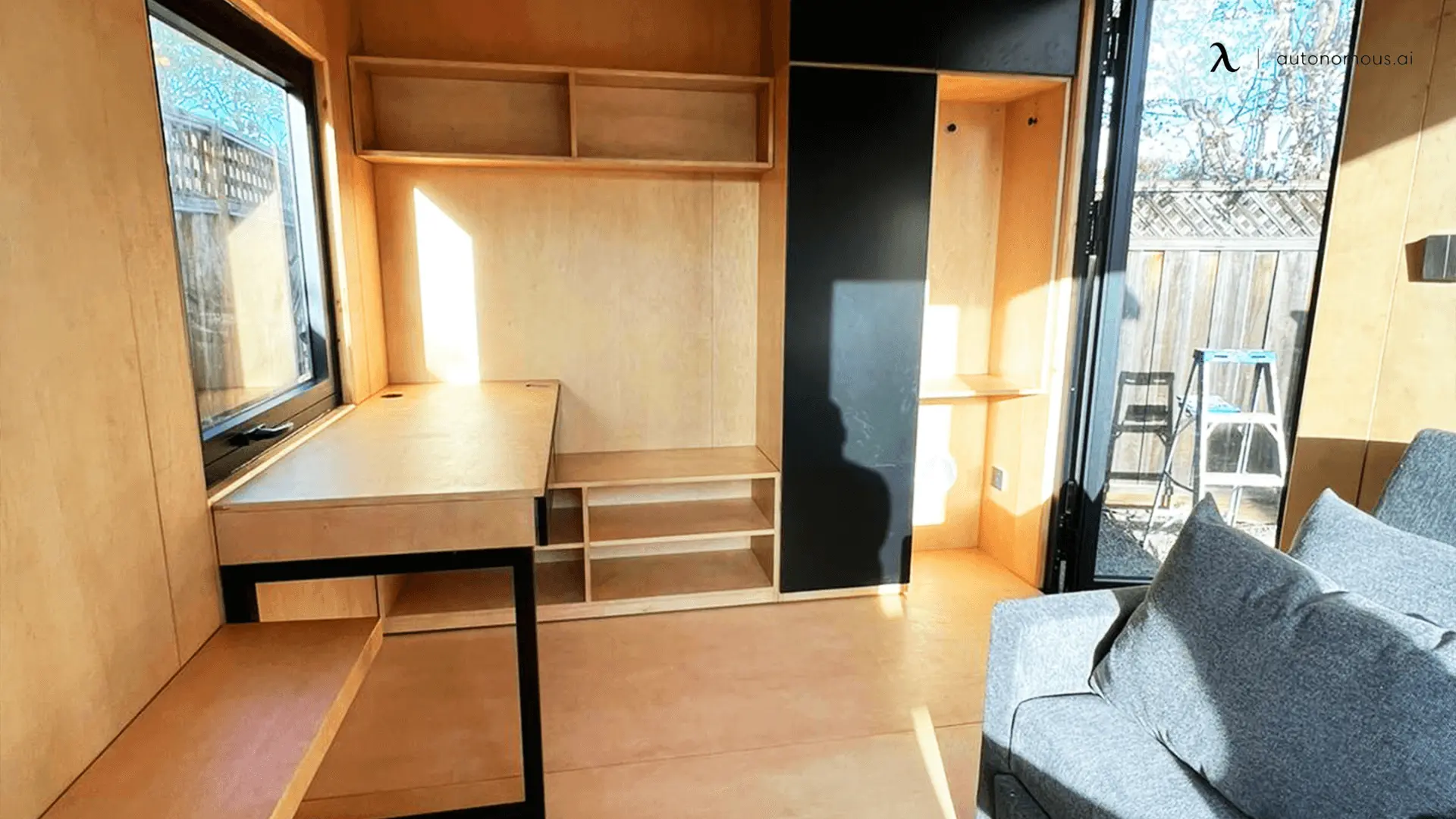
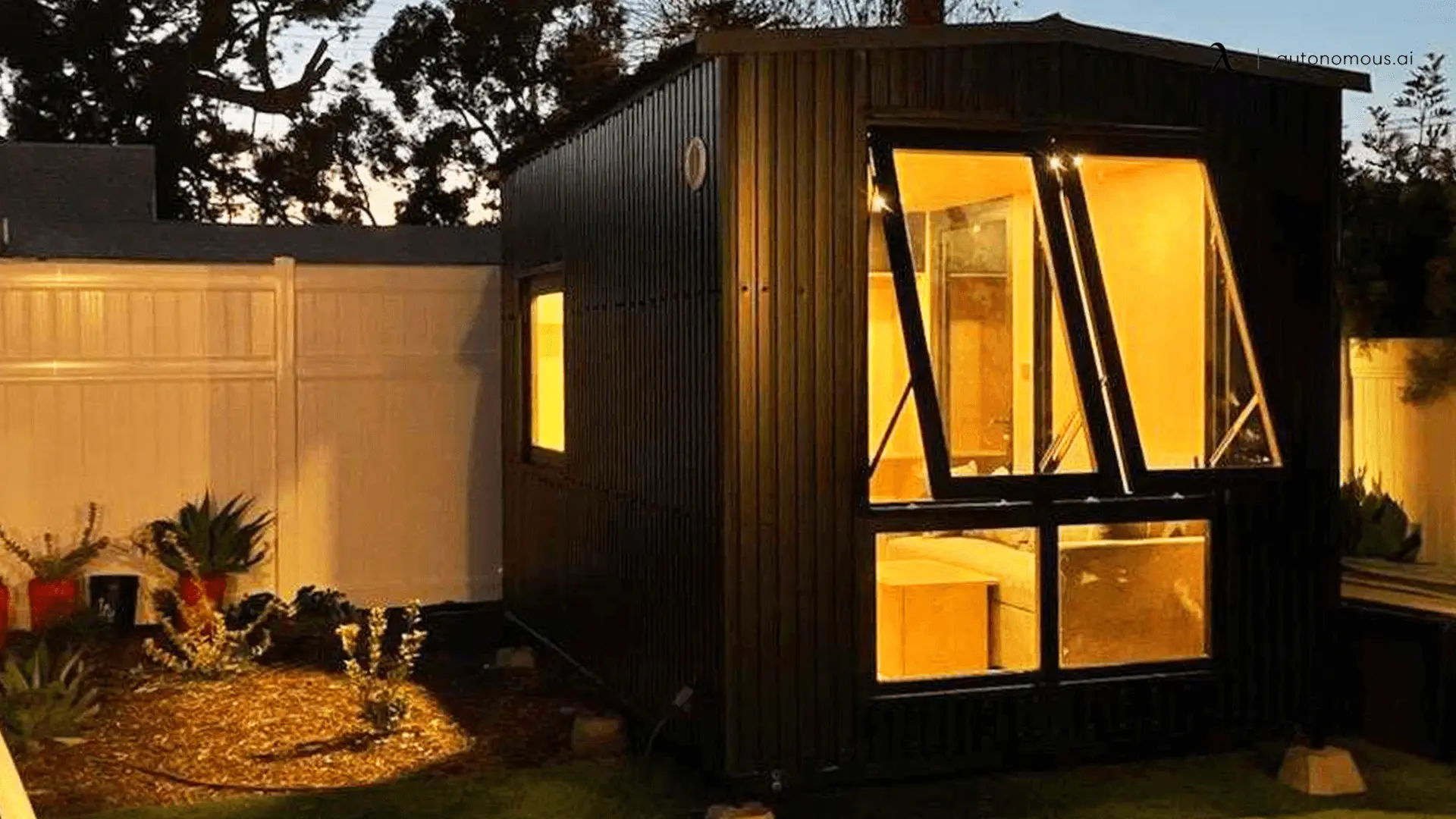
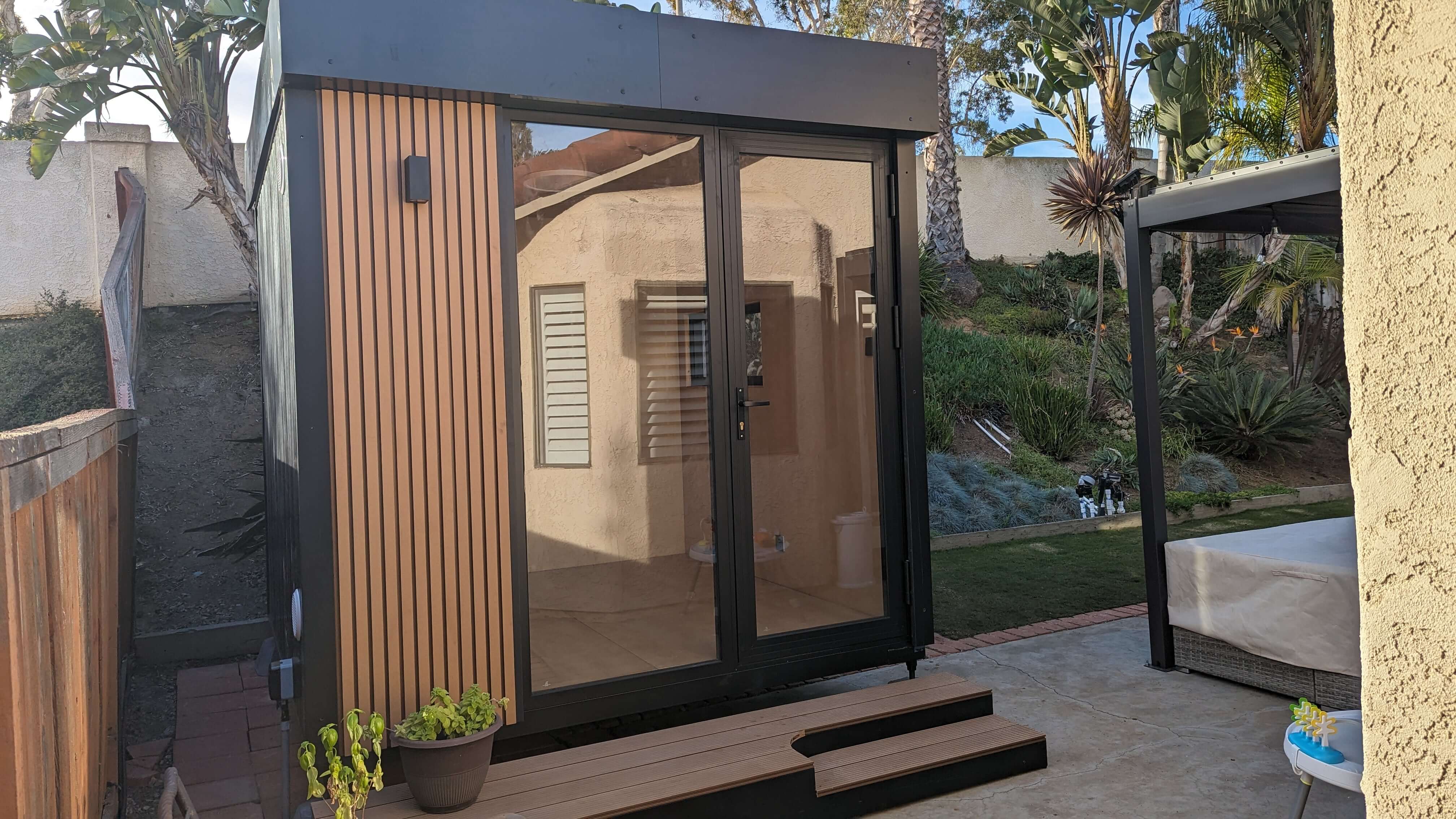
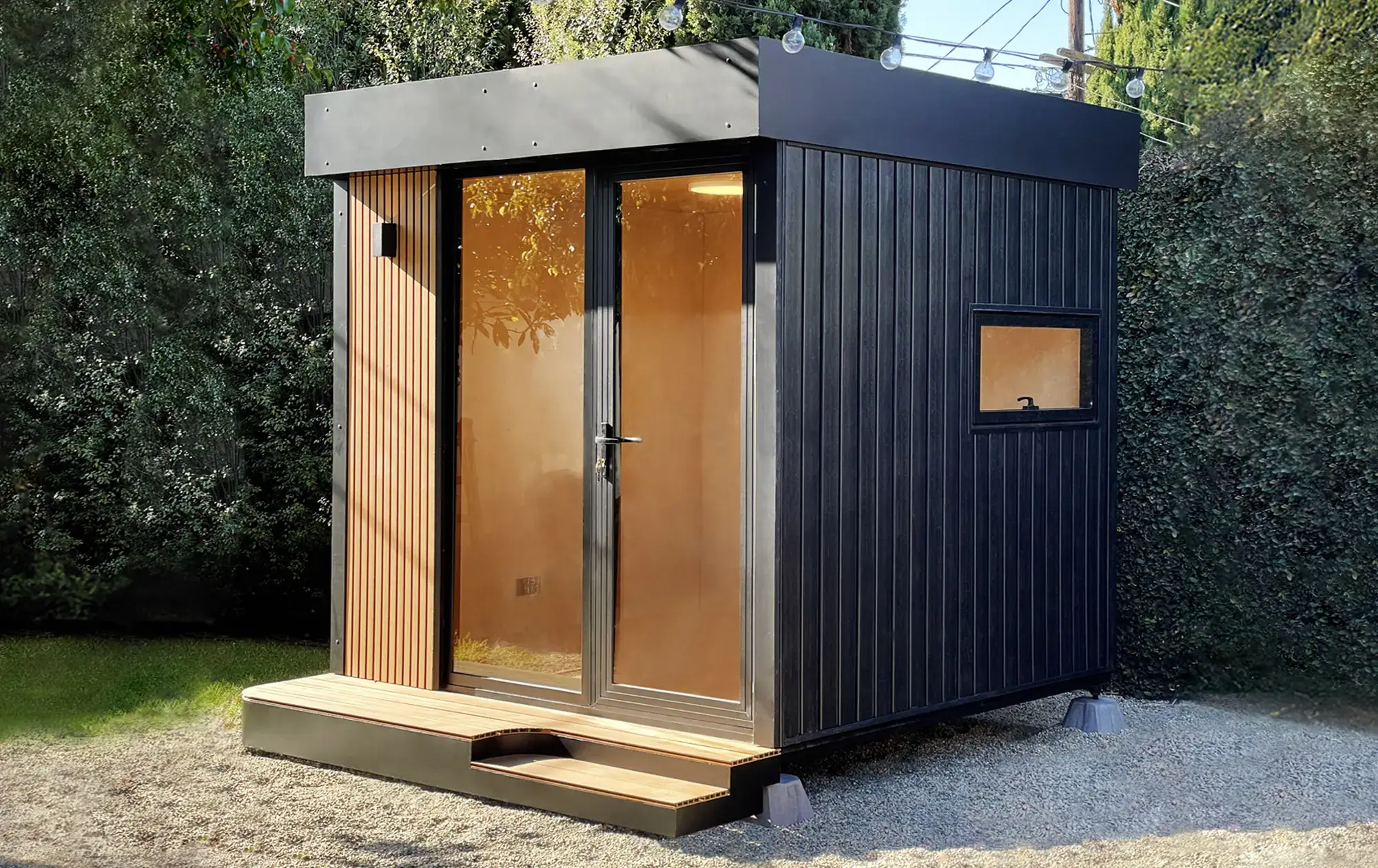
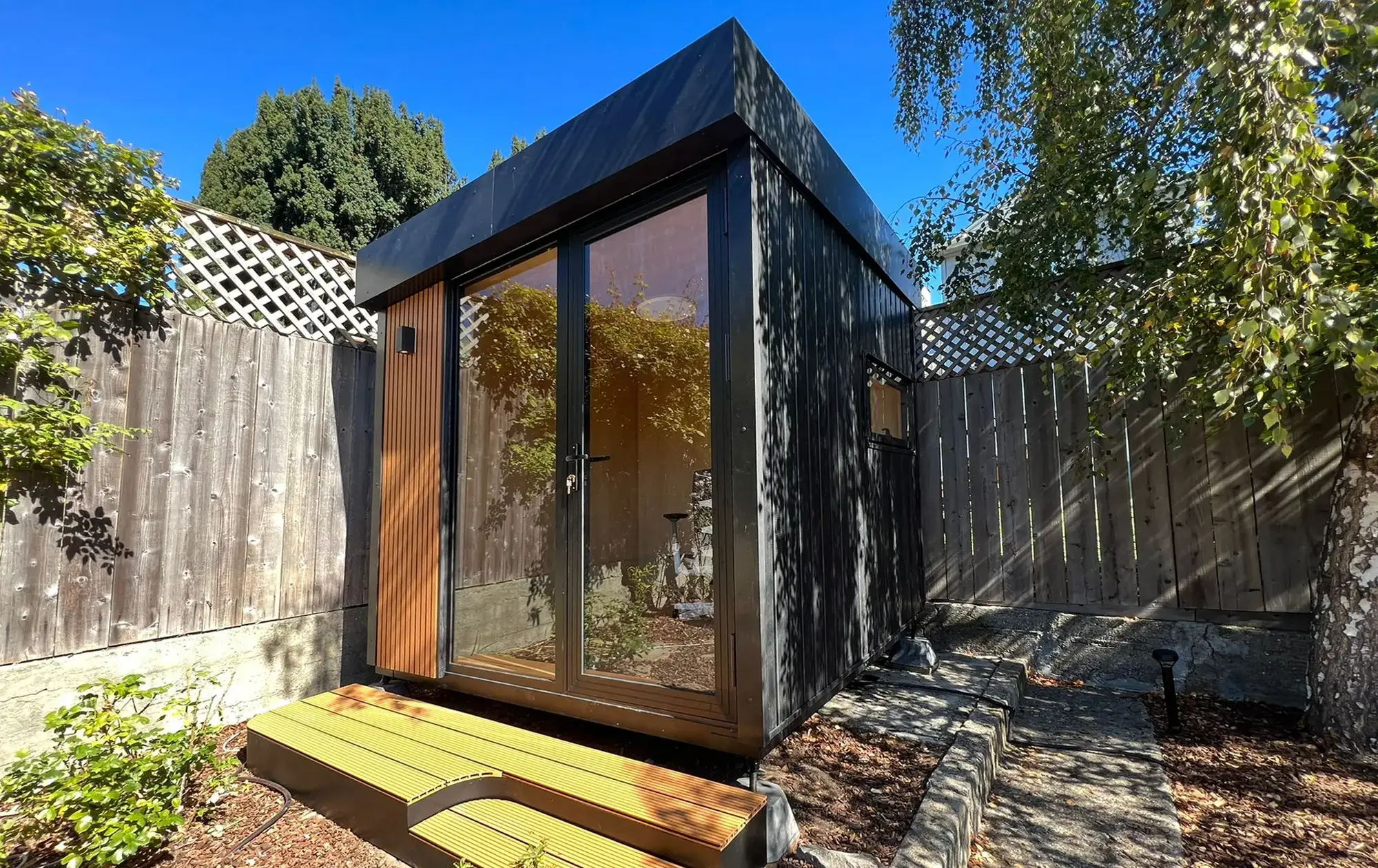


/https://storage.googleapis.com/s3-autonomous-upgrade-3/production/ecm/230914/bulk-order-sep-2023-720x1200-CTA-min.jpg)

/https://storage.googleapis.com/s3-autonomous-upgrade-3/production/ecm/230824/image_78sctd8d_1692158325567_raw-80639991-bedf-4e11-a77c-1c8e0a351b40.jpg)